Summary
- EAs in the survey reported total donations of $16.1M USD in 2018.
- The median annual donation in 2018 was $683.92.
- The median annual donation in 2018, excluding those who joined EA in 2019 was $990. This is higher than the median annual donation in 2017 of $832, excluding those who joined EA in 2018.
- 1.3% of donors accounted for 57% of donations.
- The median percentage of income donated in 2018 was 3.23%.
- 20% of EAs donated 10% or more of their income.
- The median percent of income donated by full-time employed non-student EAs who earn more than $10,000 was 3.38% and 24% of these EAs donated 10% or more of their income.
- Global Poverty charities continue to attract the largest amount of donations (39% of those who reported donations to specific charities).
This post is part of Rethink Charity's series on the EA Survey 2019, which provides an annual snapshot of the EA community. In this report, we explore donation information provided by EAs in the survey. We have already explored demographics, cause prioritization, careers and skills, and their geographic distribution.
Introduction
Earlier in this series we have shown that the most popular career paths that effective altruists in the survey (EAs) plan to follow are in earning to give roles (38%) and 55% (960) said one of the top ways in which they are interested in becoming more involved in the EA community was to give more.[1] While there has been discussion in recent years about whether earning to give should be the default strategy for most EAs or if only a small proportion of people should earn to give long term (also see discussions here and here), there is a general consensus that donating at least some amount is a good path to impact for most EAs.
Totals Donated
As in previous years, there was a very wide range in amounts donated (note the 2019 Survey collects reports of the amounts donated in 2018). All amounts are in USD ($).[2]

While total donations made in 2018 are down compared to donations reported for 2017 in the 2018 EA Survey Data, likely due to a smaller sample,[3] it is still a huge step up from what EAs reported having previously donated in 2016 and 2015 in 2017´s survey.
Excluding EAs who joined EA in 2019, the median total donated in 2018 was $990. In 2018´s EA Survey, dropping those who joined EA in 2018 the median annual donation for 2017 was $832.2. Therefore, it may be more accurate to describe the picture as one of increasing donations per EA.

As the graph below of the annual donation reported by each individual donor shows, a very small number of very large donations dwarf the size of most others.
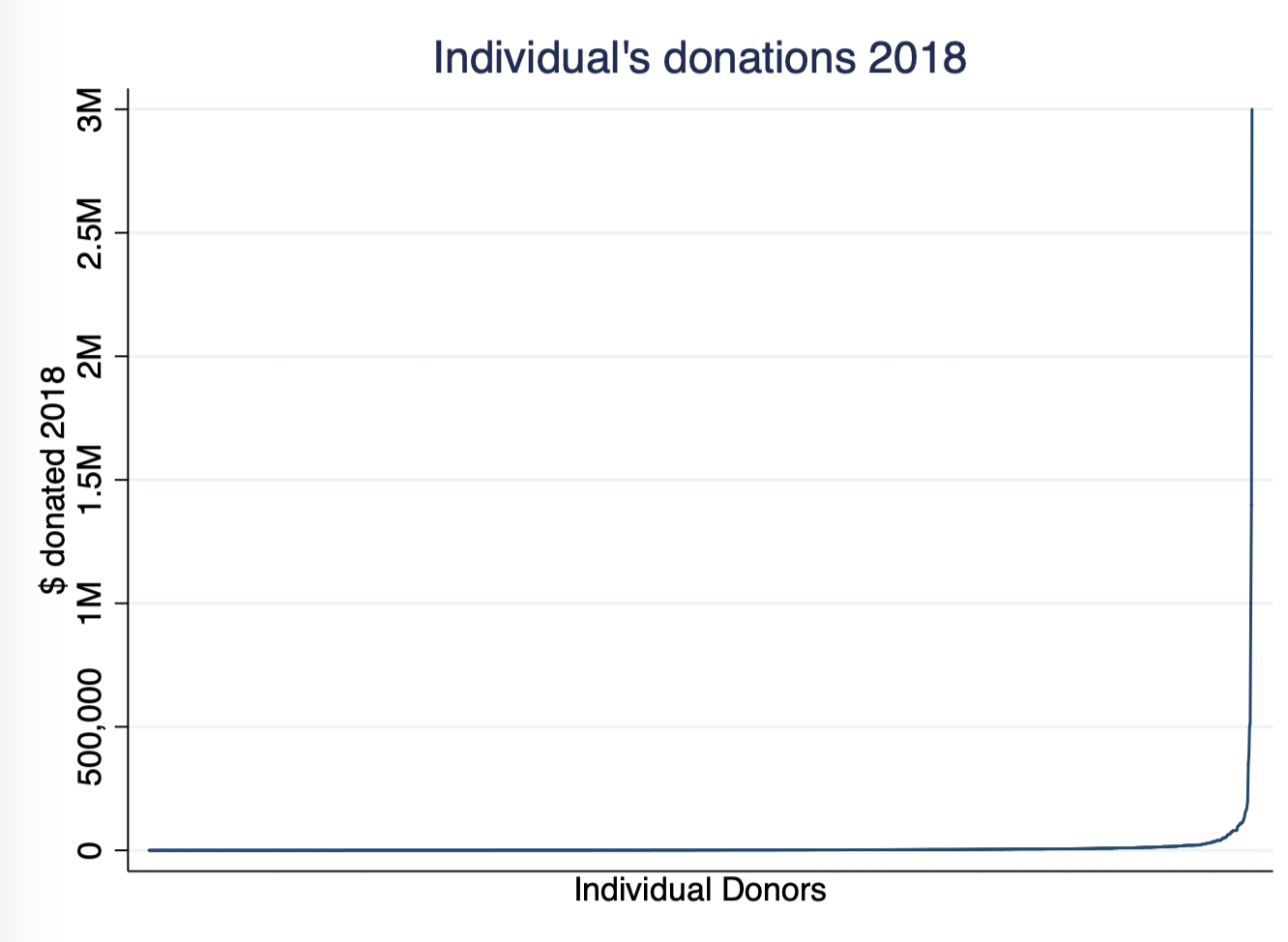
The following histogram shows the number of donors of different annual donation amounts in our sample. For illustrative purposes this histogram only represents data from those who donated $1 or more (and is presented with a log scale).
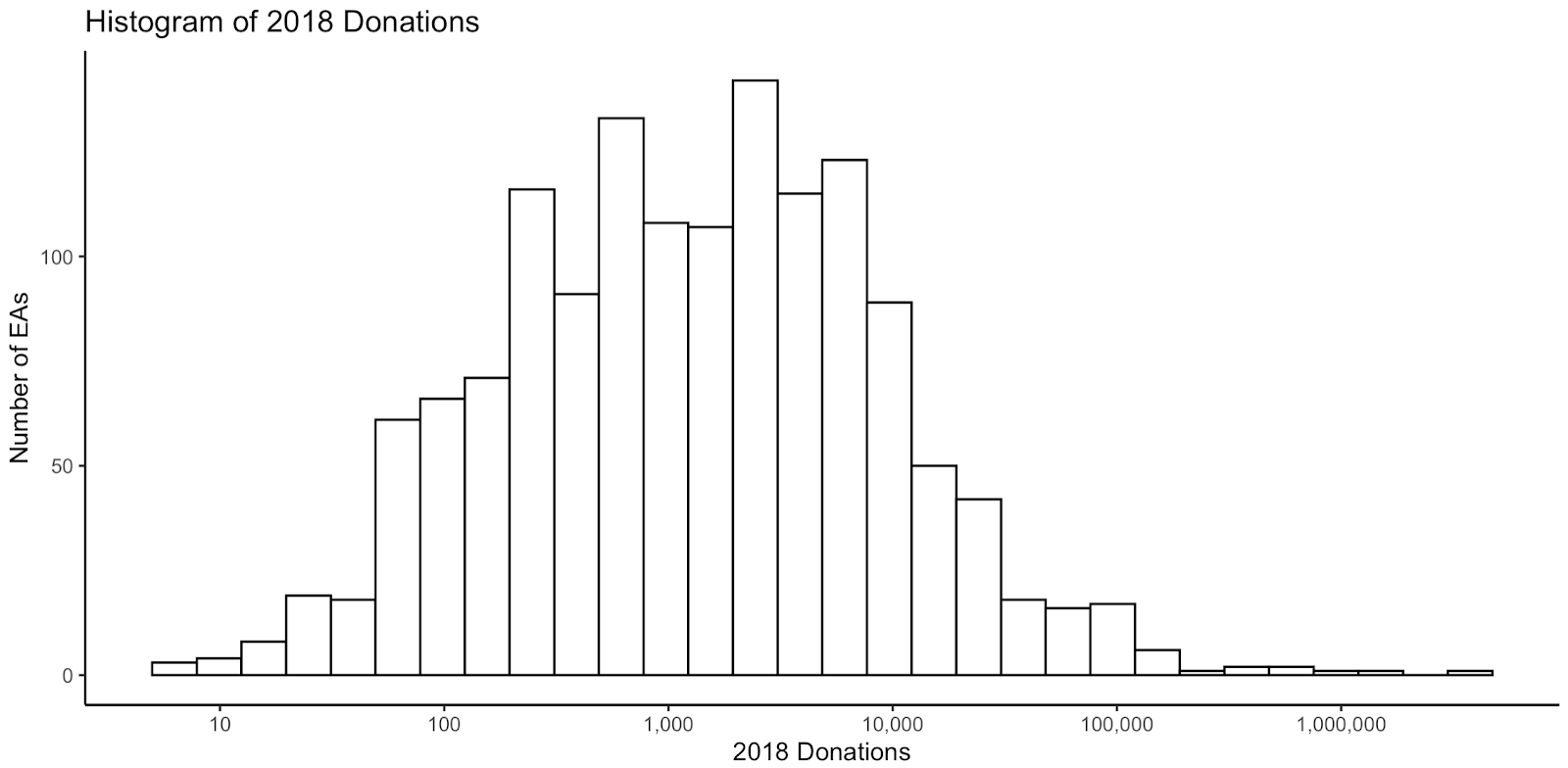
Like last year, we created a graph showing the proportion of total EA donations that came from donors of certain sizes and requested a cumulative donations graph (below). Perhaps, even if the largest donations are many times larger than the rest, much of the total might still be coming from a very large number of smaller donors?
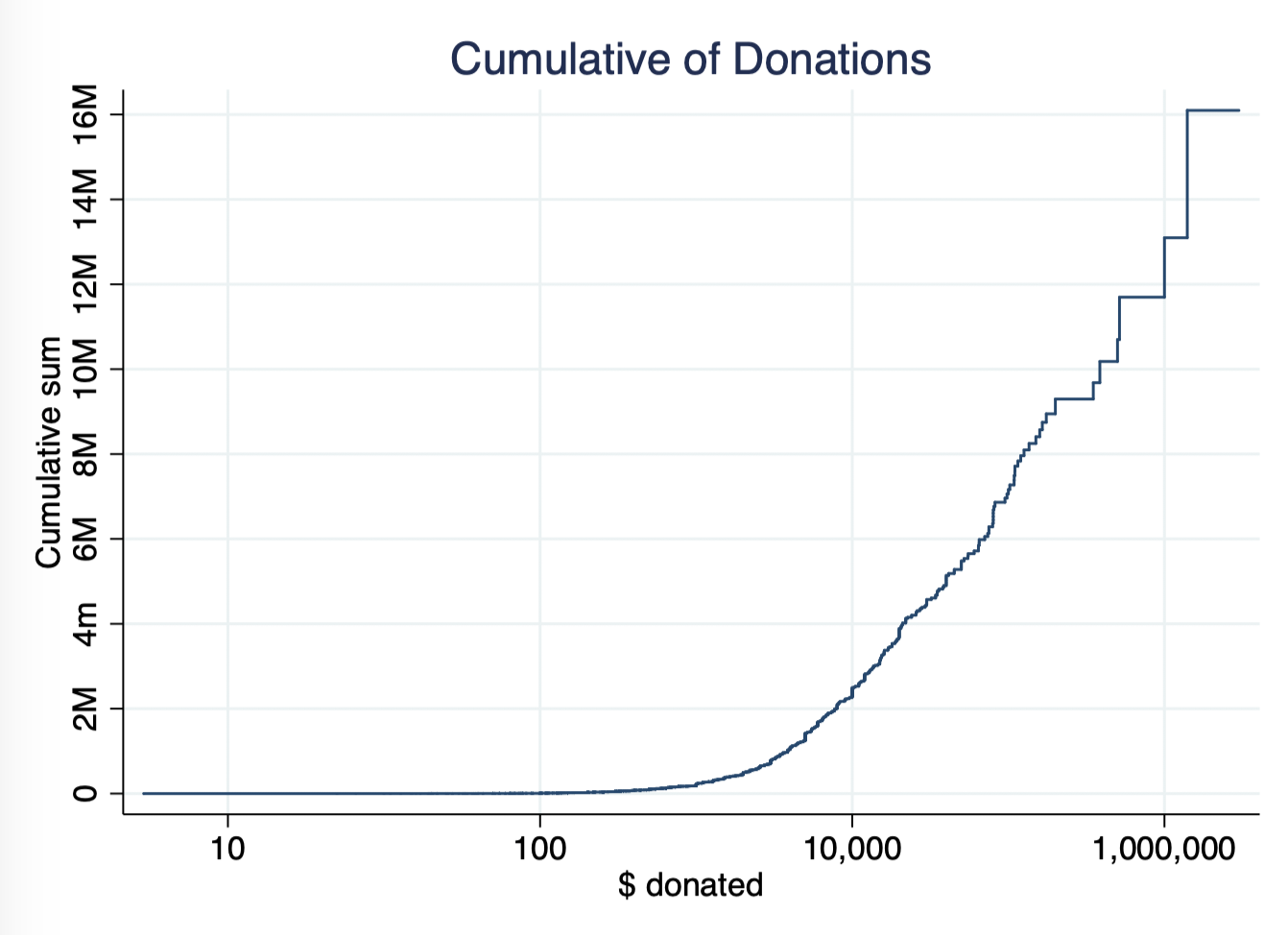
As the graph above shows, however, a relatively small portion of total donations recorded in our sample comes from those donating smaller amounts. Individuals donating $1000 or less in 2018 (55.2% of donors in our sample) accounted for $227,578.40 of donations or about 1.4% of the total. Those more in the ‘middle’, donating between $1000 and $10,000 include 34.2% of donors, and the substantial sum of $2,257,913, which is large relative to most EA projects, while still only being 14% of total donations. Those giving between $10,000 and $100,000 made up 9.4% of donors, giving $4,475,384 in sum (27.8% of donations). Conversely, donors giving more than $100,000 (1.3% of donors) accounted for $9,136,155 ( 57% of donations).
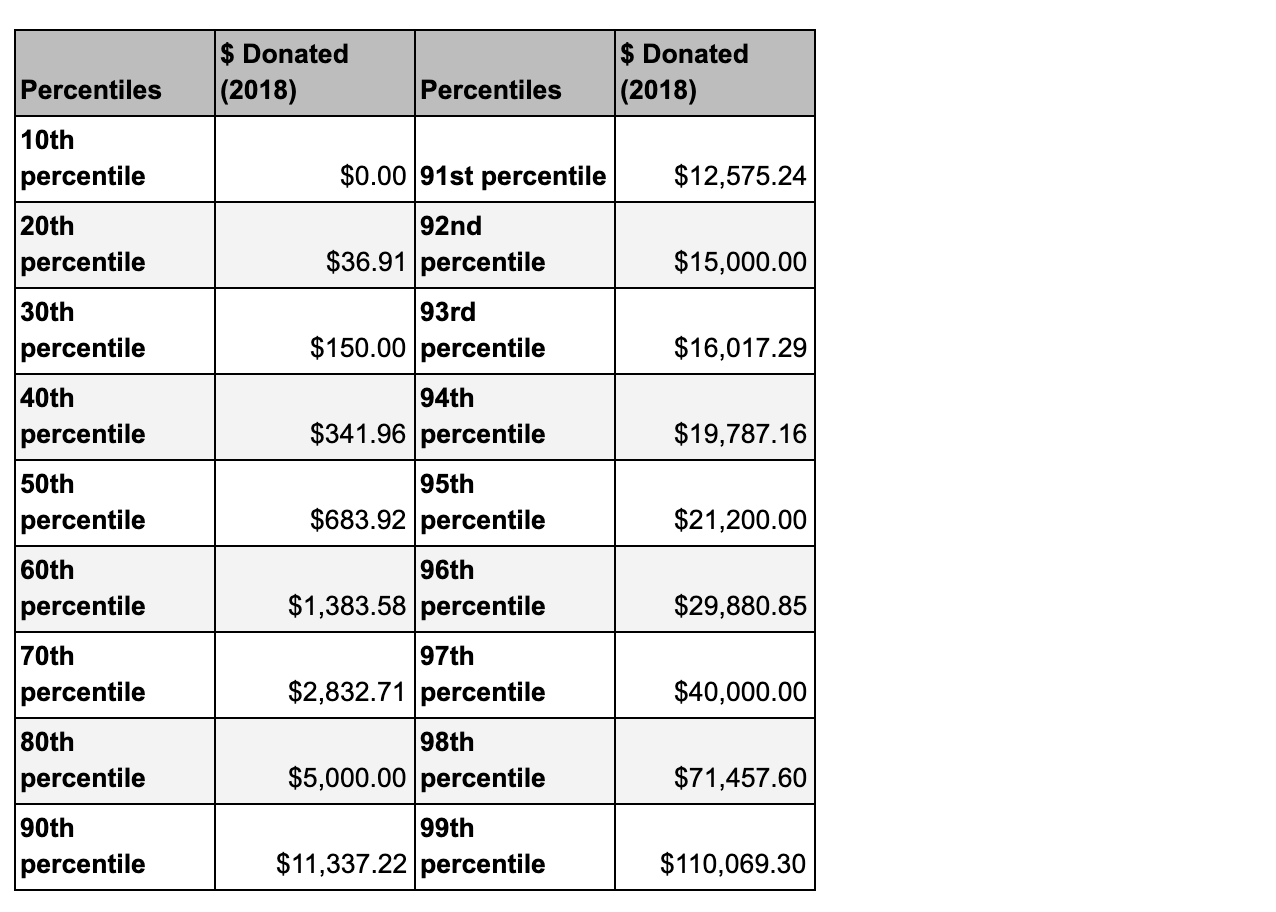
As the figures in the table above show, a donation of $1000 per year (or 5% of a $20,000 salary) would place one in the top half of EA donors (specifically, the 55th percentile), whereas being in the top 10% of donors would require donating >$11,000 and the top 1% >$110,000.
We also asked respondents how much they planned to donate in 2019. 1,716 EAs responded to this question, 1,467 of which reported planning to donate more than $0 in 2019. The median planned donation for 2019 was $1,074.98 among all EAs, and $3,000 among full-time employed non-student EAs. This would represent an increase over the median donated in 2018.

Percentages of Income Donated
We also looked at the percentages of pre-tax income that EAs were donating, based on the 1,563 EAs who disclosed both income and donation data. As in previous years, most EAs were donating significantly less than the 10% Giving What We Can Pledge. However, as the graph below shows, there is a marked ‘bump’ in the donors giving at around the 10% figure, perhaps due to the Giving What We Can Pledge target around this amount, or due to the figure’s wider popularity as a target (e.g. in tithing).

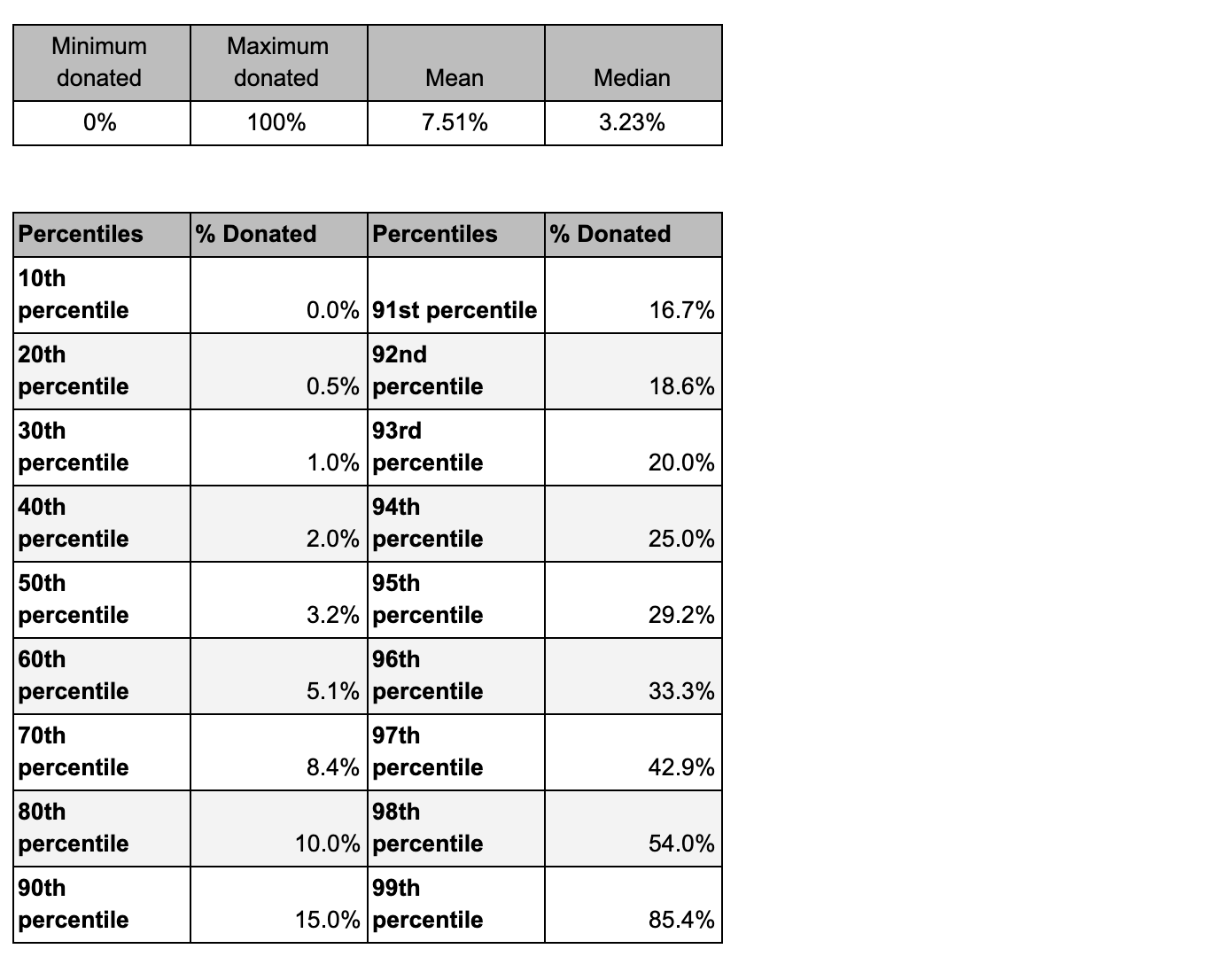
Location
Region of Residence

Dividing the data of where EAs in the survey live into four broad geographical areas, as we did in the geography post, we see the median amount donated in 2018 is highest among EAs living in the USA.
City of Residence
We can see that large metropolitan EA hubs New York City and the San Francisco Bay Area have large median donations of around $4,000 compared to other large cities like London, which has a median donation below around $770. Smaller hubs like Oxford have lower median donations, but also might be expected to have lower incomes due to a high student population.
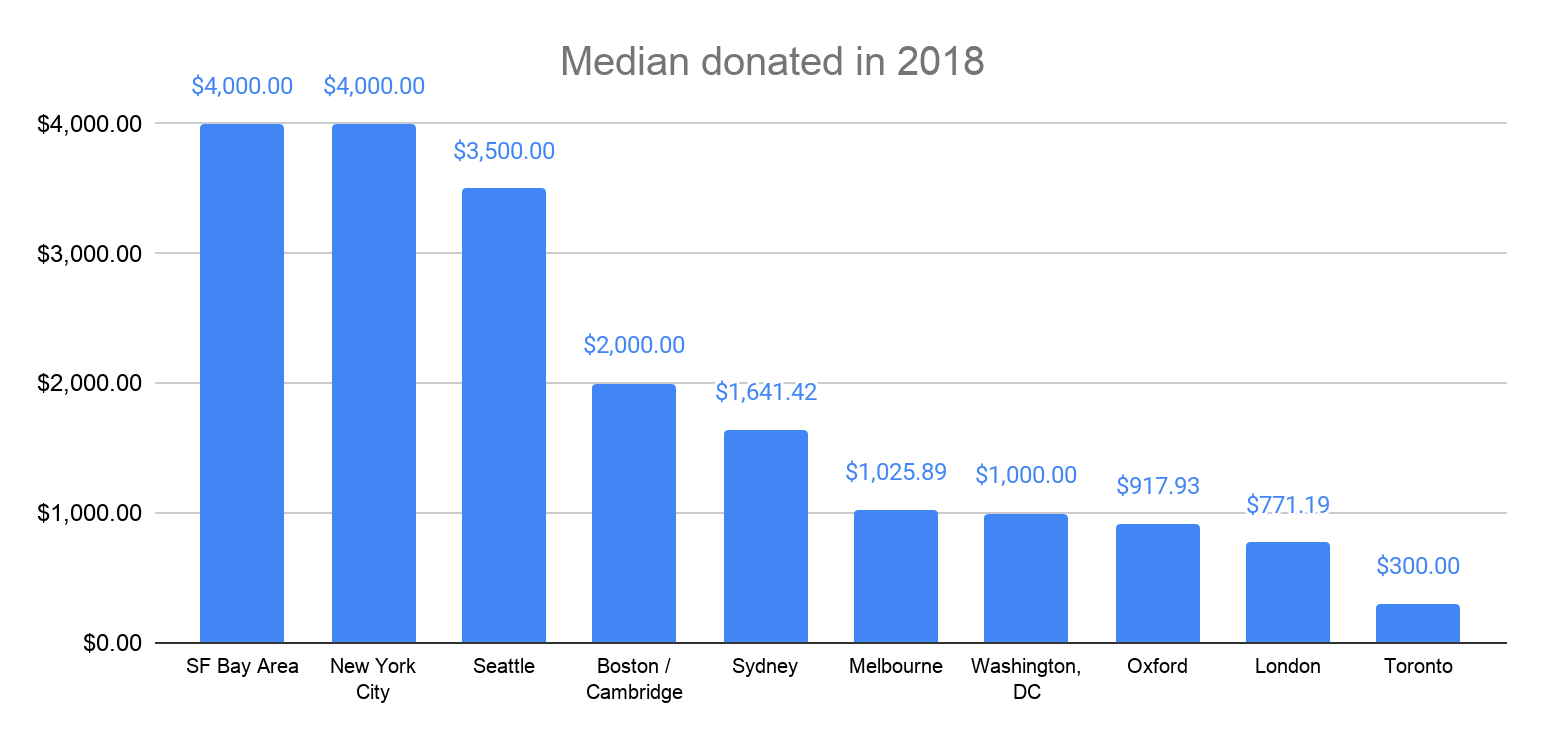
Below we see the median percentage of income donated by Oxford EAs is very similar to that of San Francisco Bay Area EAs (~6.5%), who on average have higher incomes. Again we see that London EAs fall behind other metro hubs in terms of % of income donated (2.9%).
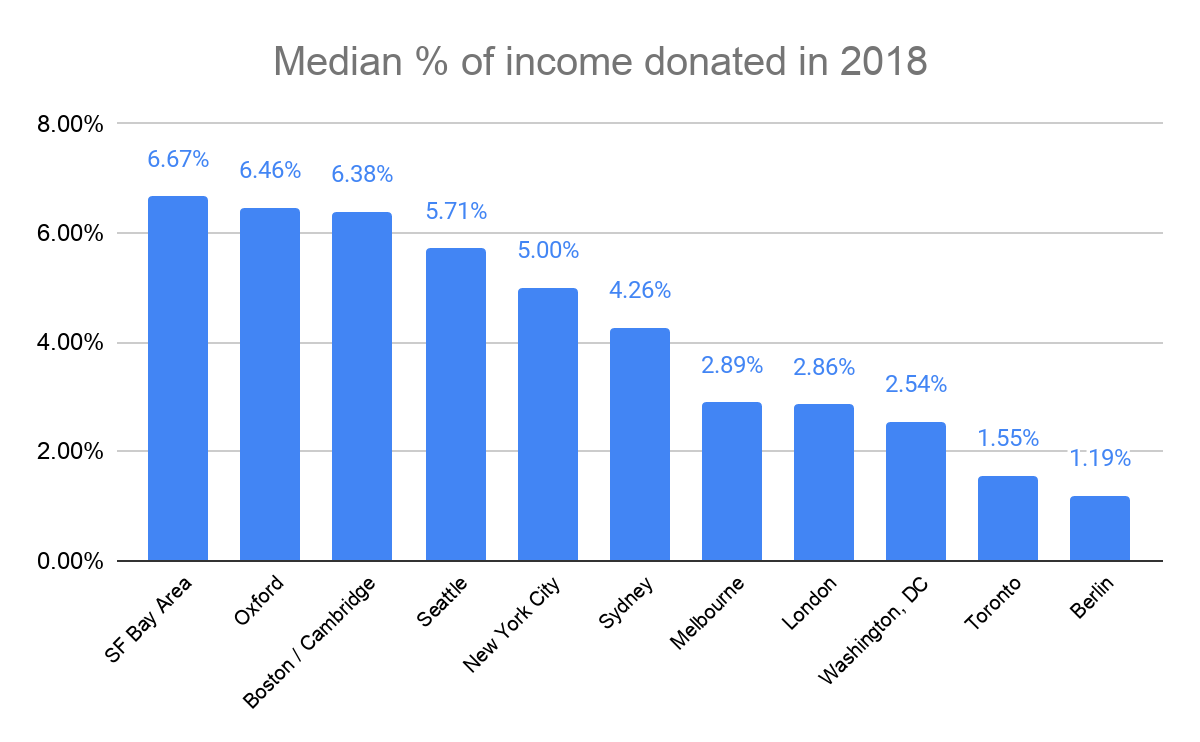
Self-reported Engagement in EA
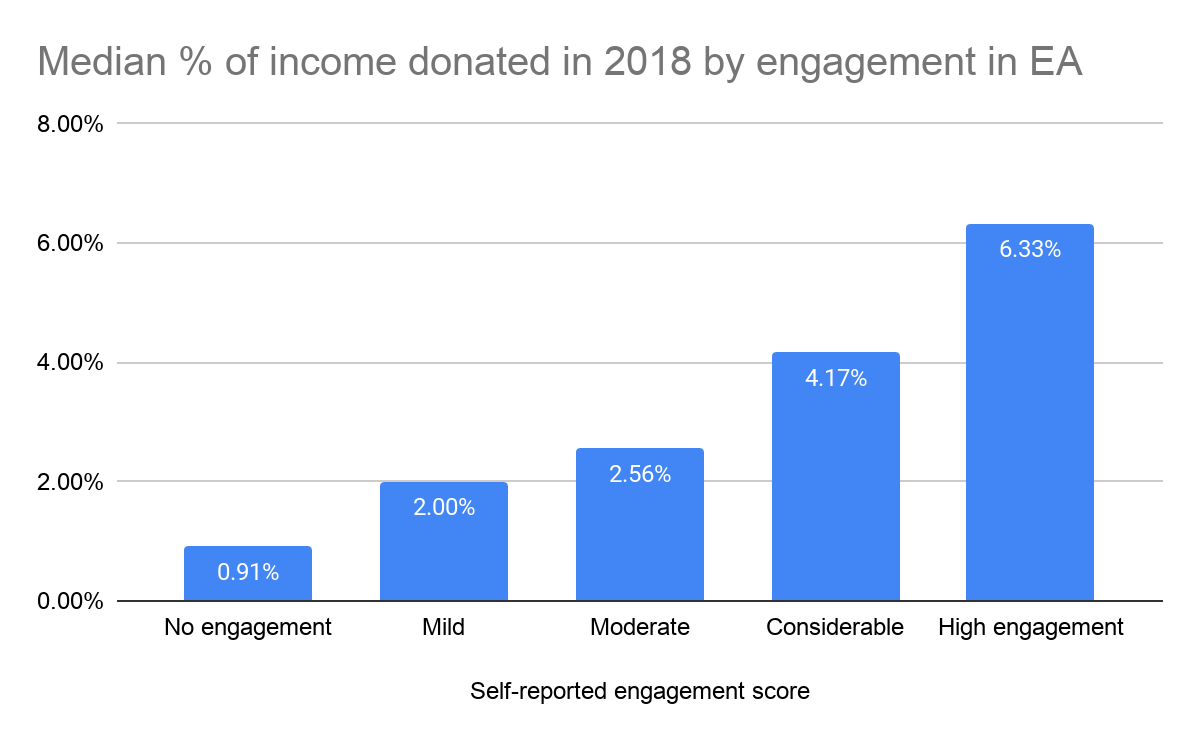
We see highly engaged EAs donate the highest percentage of income. This is despite the fact that less engaged EAs tend to have higher median incomes and more engaged EAs tend to more often be students than less engaged EAs. The increasing trend appears whether one looks at full-time employed non-students or students. Highly engaged EAs report the highest percentage of income donated but are less likely to be following Earning to Give career paths (25% among non-students) compared to lesser engaged EAs (42% of considerably engaged, 48% of moderately engaged EAs, 38% of mildly engaged EAs, 22% of non-engaged EAs). The median annual donation is highest among the second most engaged group of EAs, with other engagement levels having similar median amounts to each other (except no engagement for which the number of respondents is very low anyway).[4]
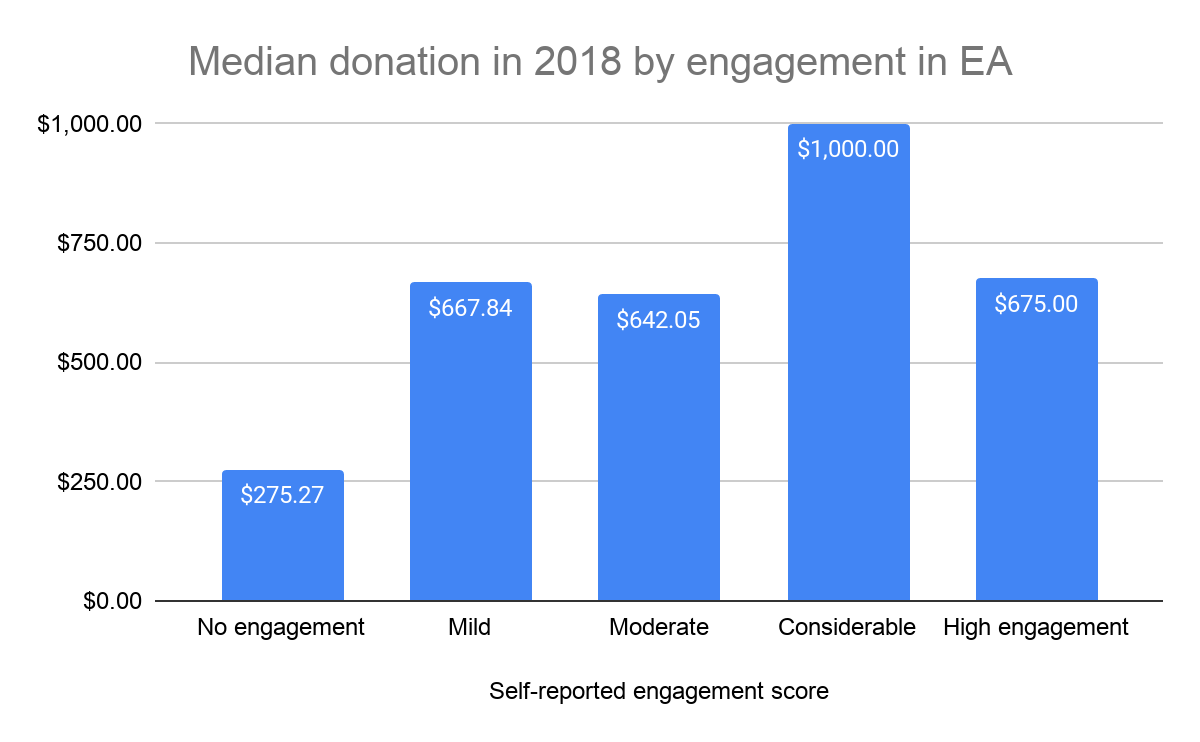
What Explains Low Donations?
In previous years, readers have commented on the large numbers of EAs who appear to be donating $0 or close to $0 and at their surprise at low donation levels overall. This may be less of a surprise today compared to when earning to give and the Giving What We Can Pledge were emphasised more in the community, but it still appears to us to be worth investigating.
Respondents also offered open comments about their donations. Of the 146 who reported donating nothing and gave a comment, ~39% reported not donating because they were a student, ~20% reported that their income was too low to donate, another ~10% reported planning to give later, and ~8% reported that they were donating-in-kind (such as working at an EA organization or working in an EA cause area).
Students
Many EAs are students (of those who reported donation information, ~31% were students) and students are generally expected to be donating lower amounts (the GWWC pledge only requires students to donate 1% rather than 10%). True to expectations, our data confirms that students do donate less in both absolute terms and as a percentage as income.
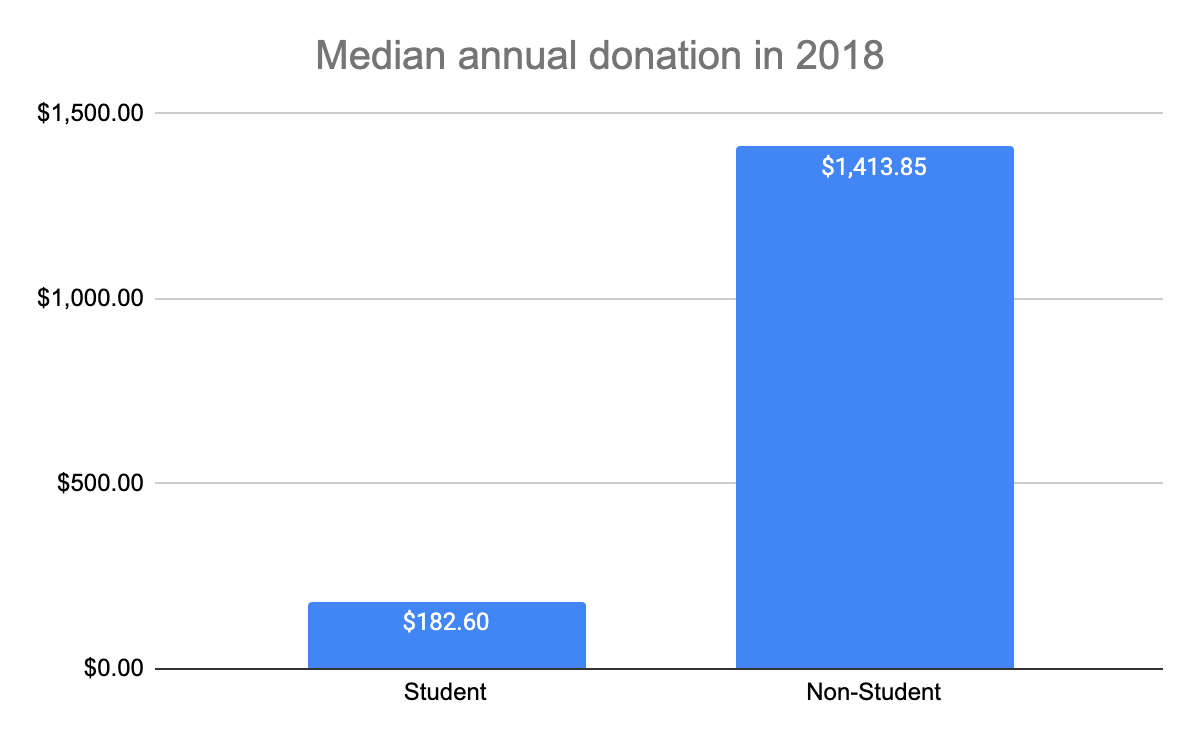

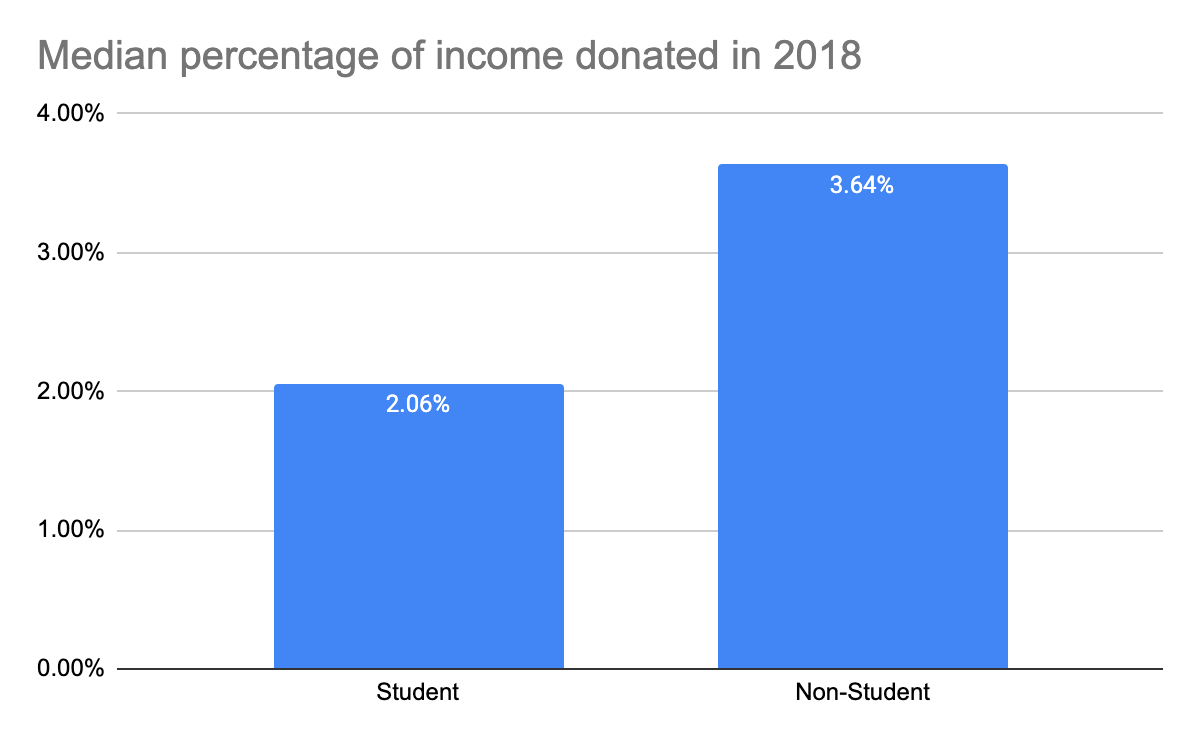
Employment
Similarly, many EAs in our sample, though not students, may not be employed or fully employed. When we exclude both students and those who are not employed full-time, median donations are, again, substantially higher.


Despite this, the percentage of income donated even among full-time employed non-students was very low, with a median of 3.4% income donated (and 2.9% among “other”). Indeed, only the 76th percentile of full-time employed non-students was donating 10% or more with the 90th percentile donating 14.86%.
Income
The fact that donations are higher among full-time employed non-students may well be expected to be largely due to higher income. Indeed, within the sample as a whole, we found that donations in 2018 were strongly correlated with income ( data in the figure below excludes donations and income below $1).[5]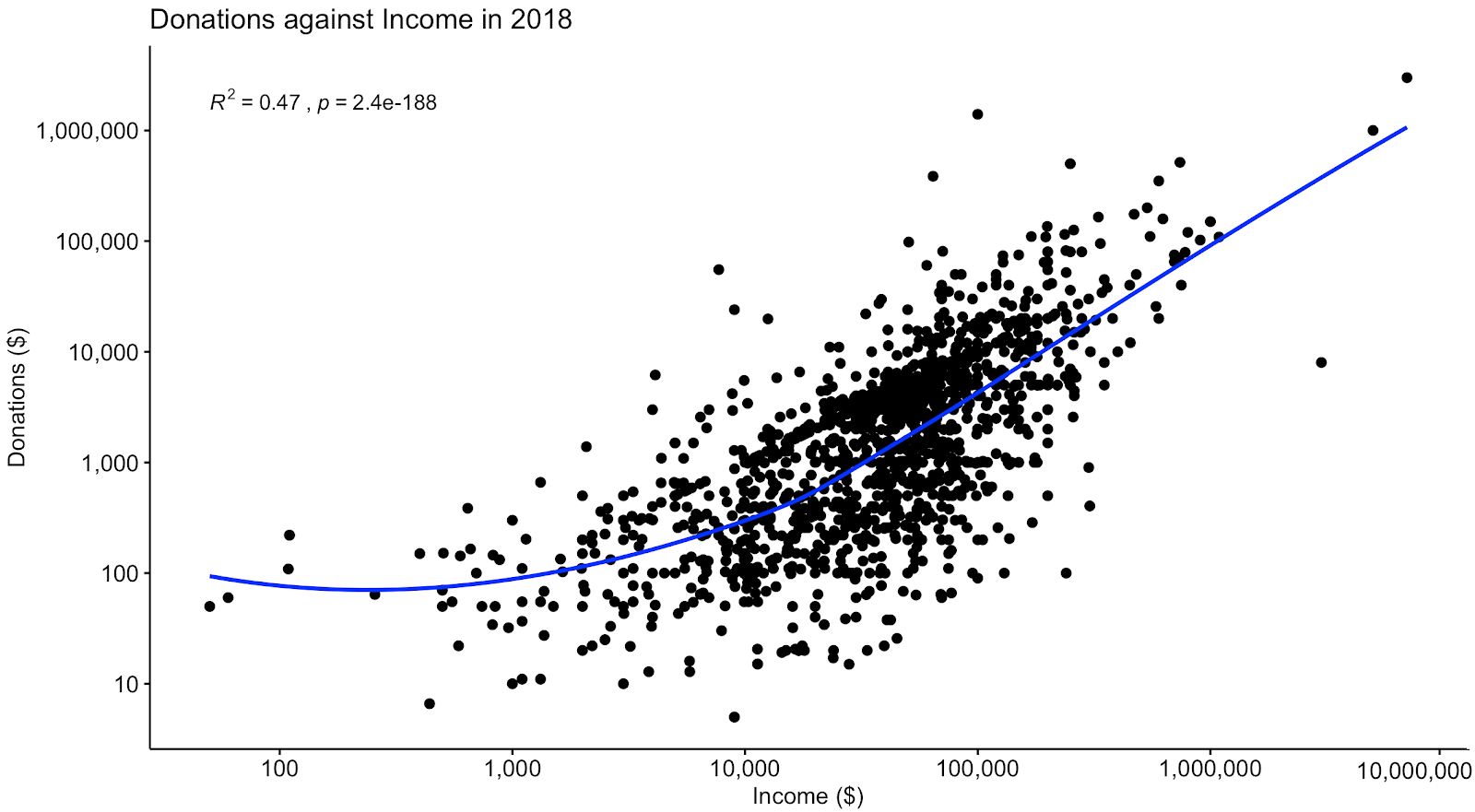
Restricting our data to only full-time employed non student EAs earning more than $10K, the median percentage of income donated in 2018 was less than 3.38% for 50% of this group, and their median total donated is $2,000.
Giving What We Can Pledge
The observation that so many EAs in our survey were donating much less than 10% of their income to charity suggests the question: how much are self-reported GWWC Pledge takers donating?
In the EA Survey 2019 data, the median percentage of income donated by someone who had taken the GWWC Pledge was 8.87%, short of the 10% target, though there could be some noise around how respondents reported income and donations. Nevertheless, this of course could be influenced by GWWC Pledge takers being students, not employed or only recently having taken the Pledge. We addressed this question in more depth last year: GWWC members donate more than non-GWWC members, both absolutely and as a percentage of income but ~40% of self-reported GWWC members were not reporting donation data that is consistent with keeping their pledge, a trend most likely to be the result of attrition over time.
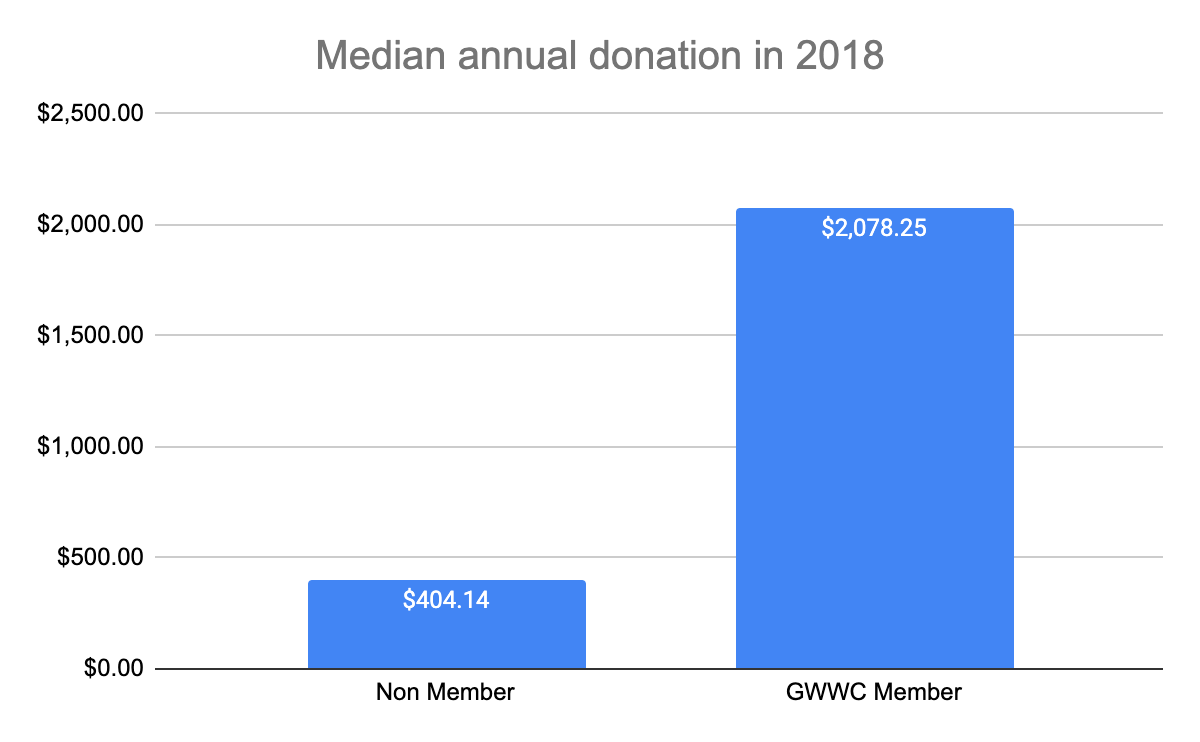
Years in EA
Like last year, we see a general trend of veteran EAs donating on average more than new EAs. Those who have more recently heard of EA tend to be younger, more likely to be students (or may be earlier in their careers) and so have a lower income. In addition, new EAs might also be expected to be less likely to be extremely dedicated or willing to donate large sums right away. There may also be some survivorship bias, where those EAs who report first hearing of EA in earlier years, and are still taking the survey in 2018, may be more likely to dedicated, highly involved (and perhaps higher donating) EAs. It could also be that early adopters of EA were more influenced by more prevalent community norms at the time of giving more and have kept up this high giving rate even while the focus of the movement was broadened over time.
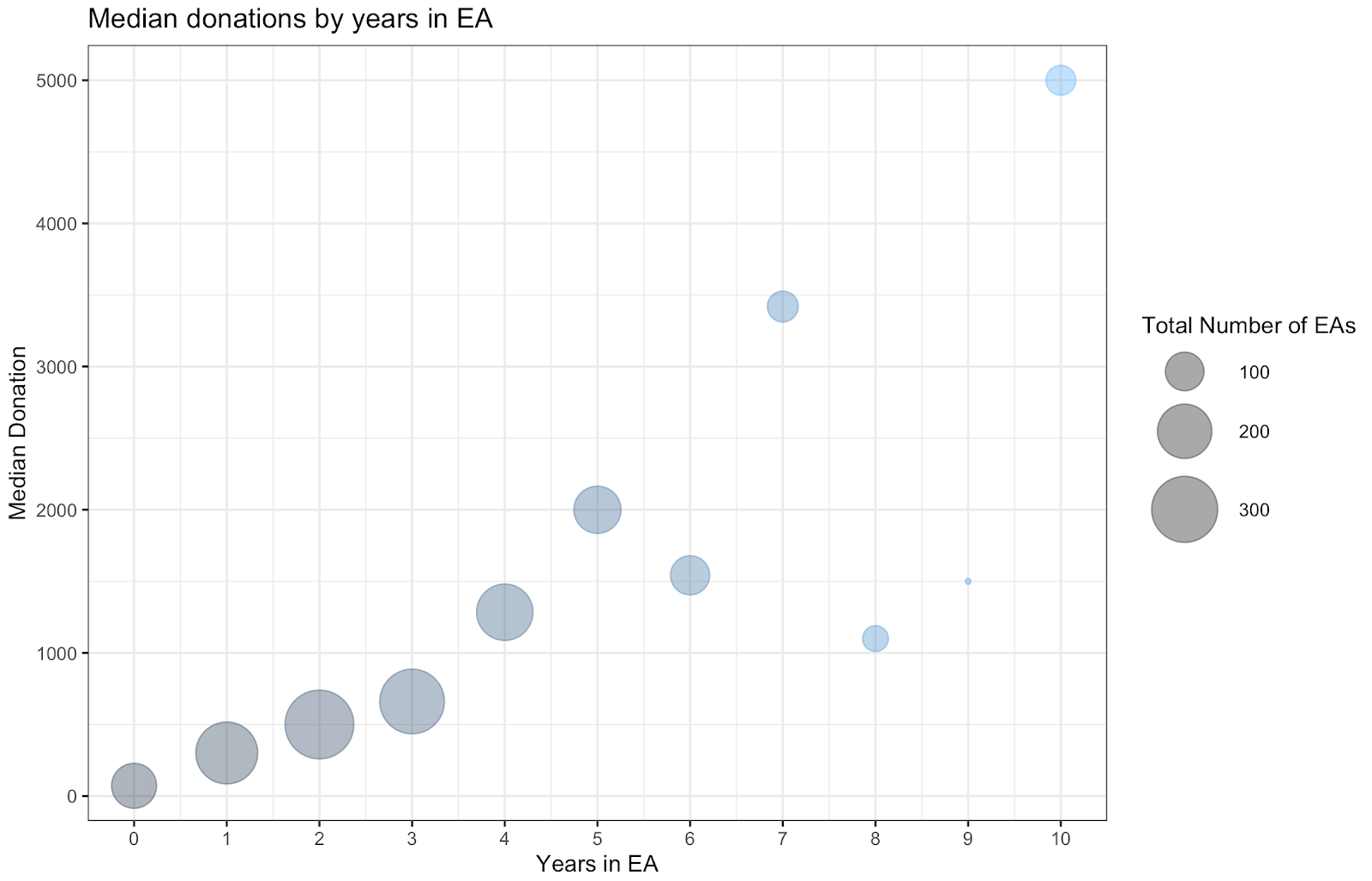
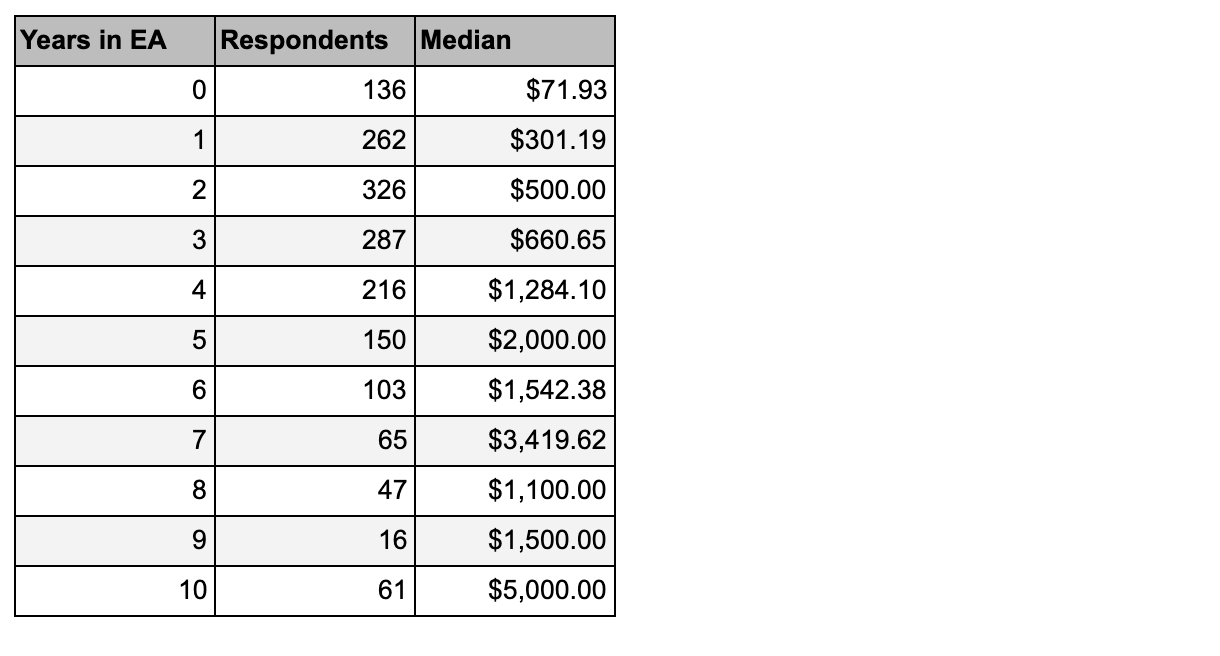
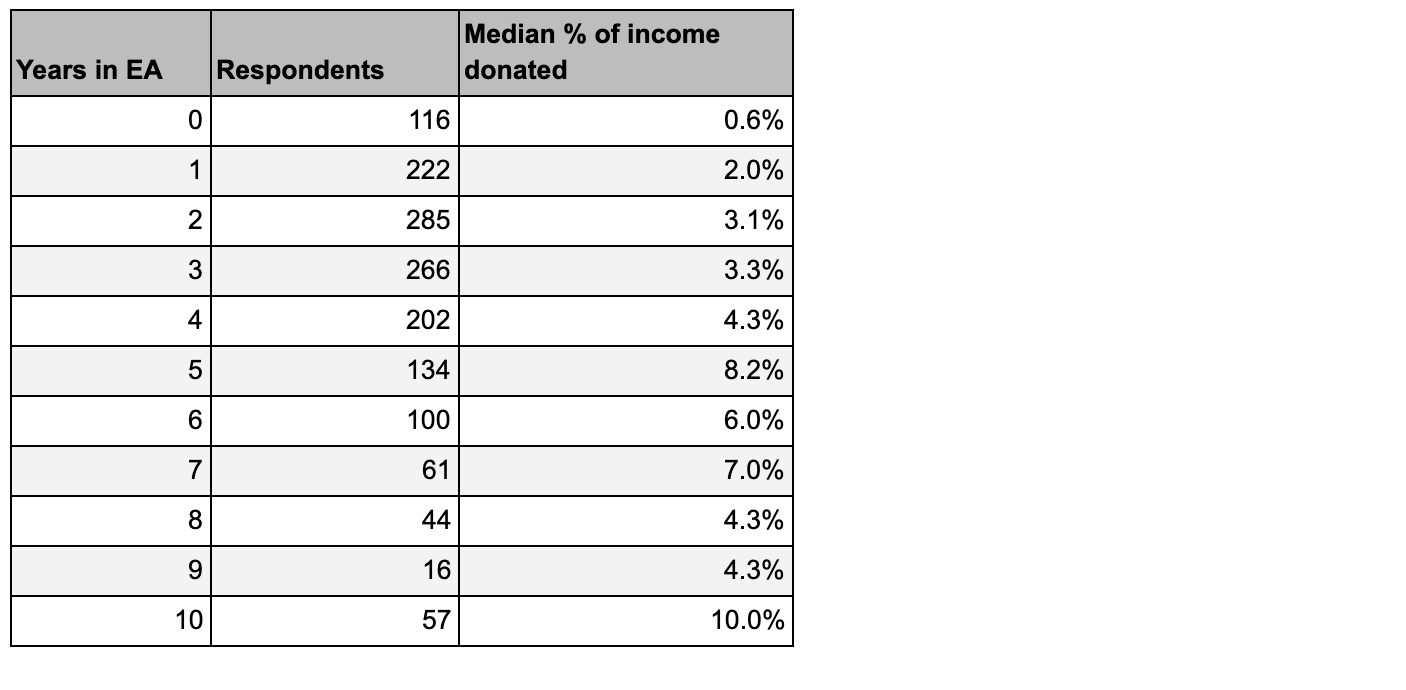
Predictors of Donation
Based on the results last year, we again examined the effect of income, student status, number of years involved with EA, and membership in GWWC as potential predictors of donations. The results of a regression analysis are again suggestive of a relationship between these factors and donations, namely that those with higher incomes and GWWC members tend to donate more than those with lower incomes or who are students. Like last year, we ran a full model with all interactions, and used backwards selection to select predictors. Individual income was the strongest predictor of donation amount, followed by a positive impact of membership in GWWC interacting with income (link to regression table). Before analysis, one outlier with large influence was removed (individual income >$7 million), and the data were log transformed, centered, and scaled to improve normality. As previously noted, there was a small negative impact of being a student on donation amount. As seen in the figure below which charts donations against income with a lowess regression line, this effect was slightly mitigated by being a member of GWWC. Attempting to model the likelihood of donating any amount versus donating nothing did not prove very fruitful as models with an even larger set of potential predictors could only explain ~6% of the variance.
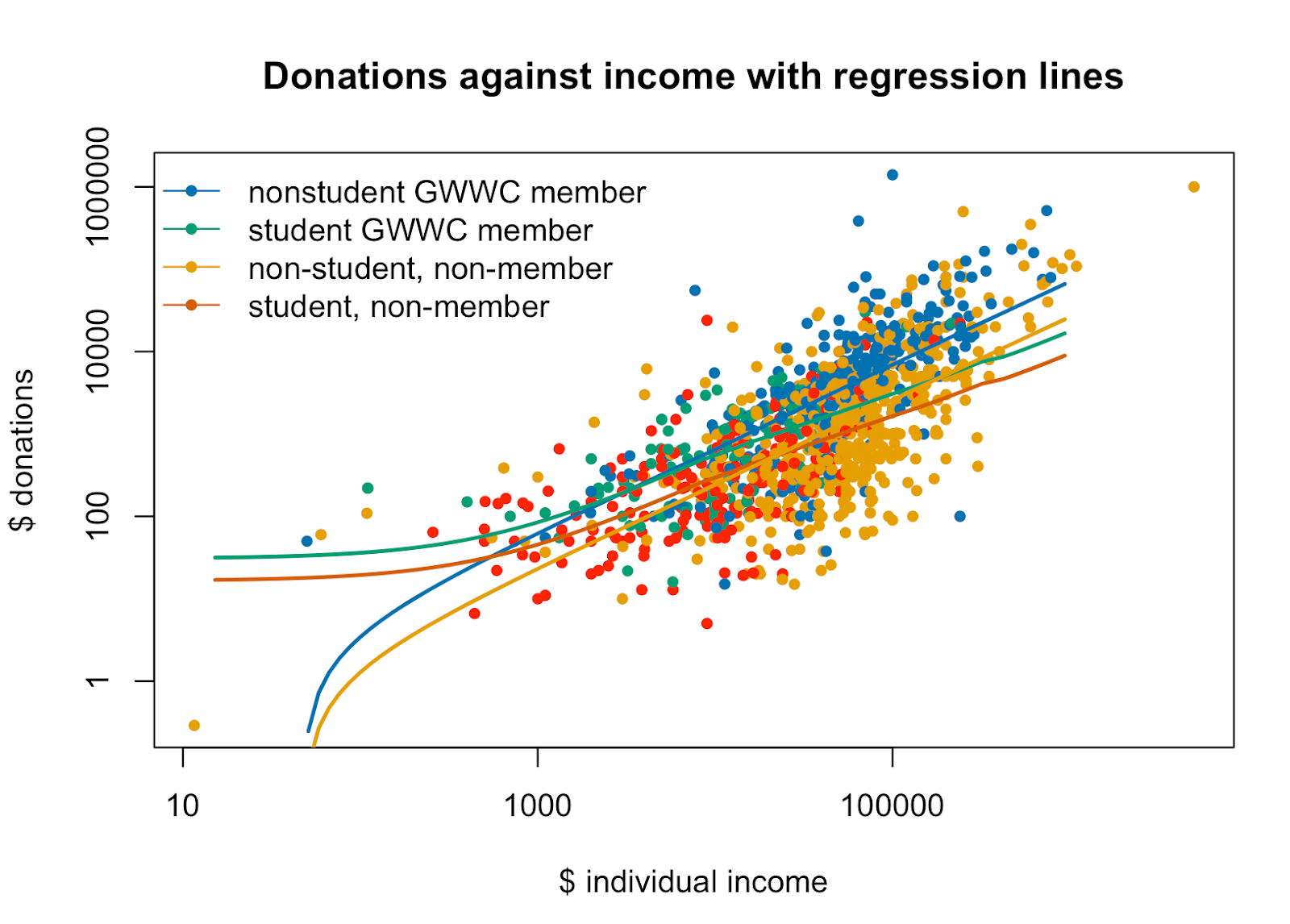
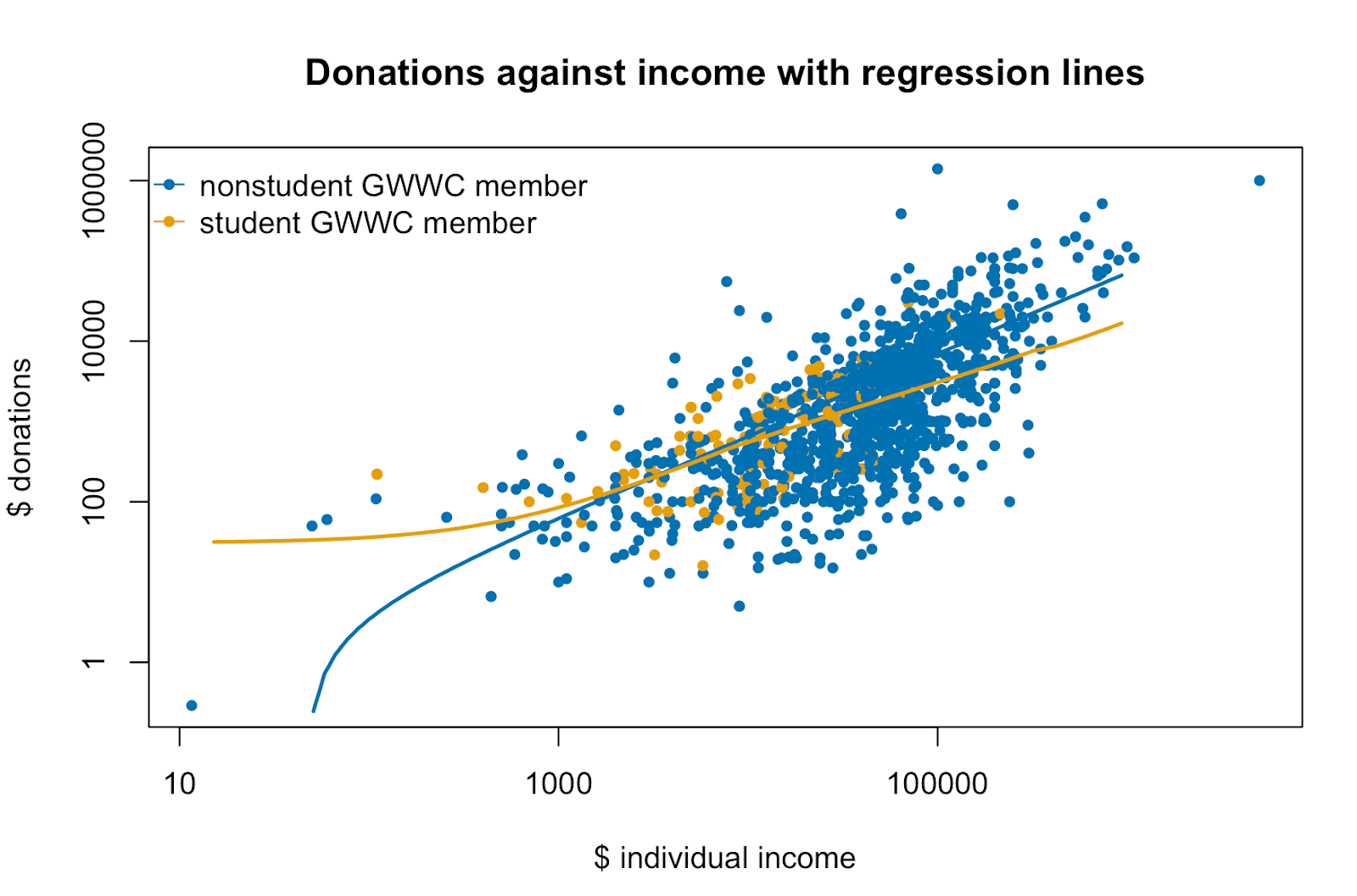
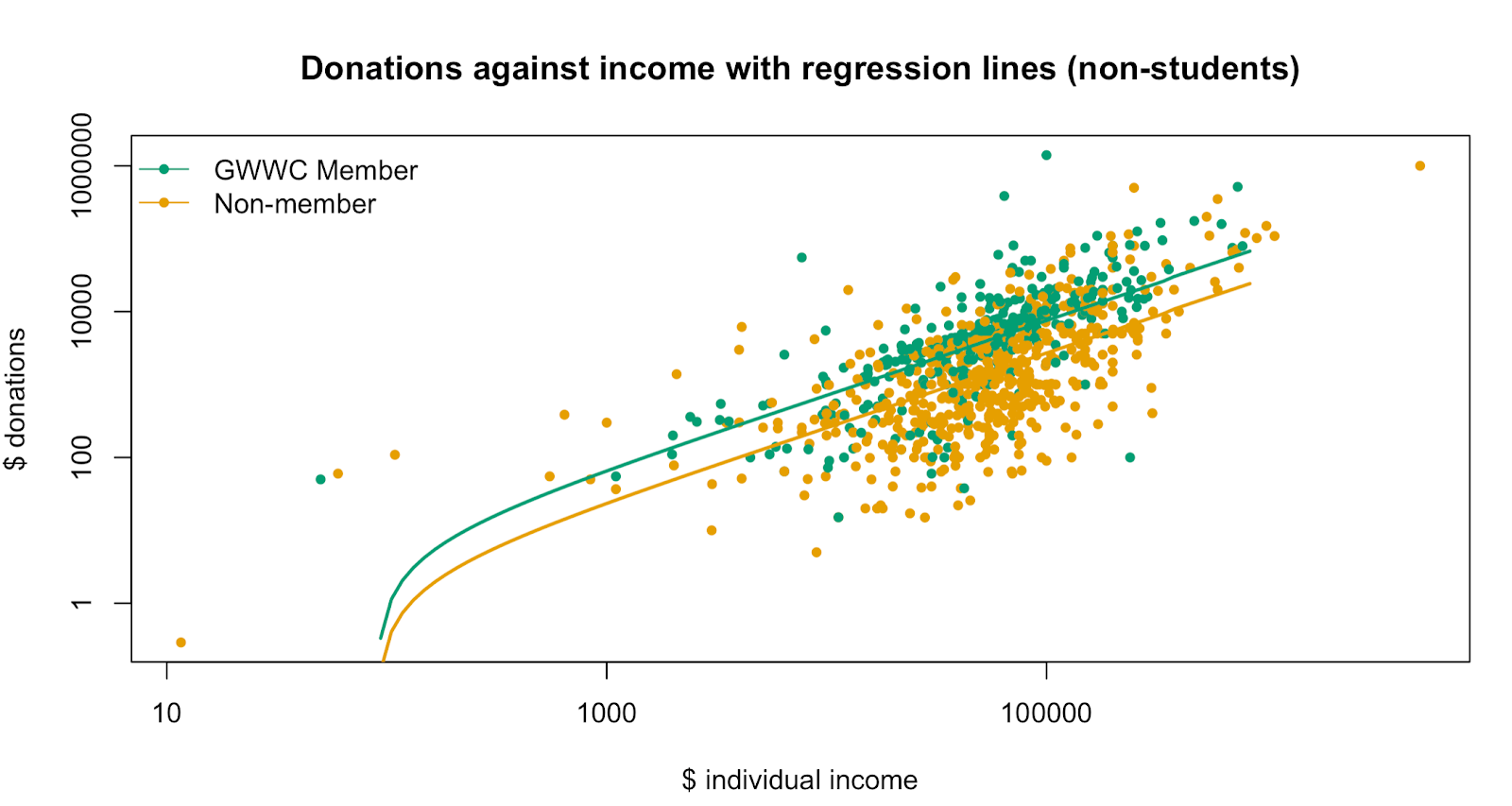
Which Charities are EAs Donating to?
We received information about which specific charities respondents donated to from 749 EAs, compared to 1,745 who reported donating anything in 2018. Given this, information about totals of donations to specific charities should be treated with caution.
As in previous years, GiveWell charities, led by AMF, received among the most reported donations. GiveWell itself attracted substantially more funding and more donors than in 2017, among those who reported donations in our 2018 and 2019 surveys. The combined EA Funds would be the 3rd largest recipient. The Effective Altruism Foundation received the highest mean donation (excluding CFAR as only 1 respondent reported donation information). When grouped into cause areas, the largest amount of donations went to Global Poverty, although the largest mean donation was for Meta Charities.
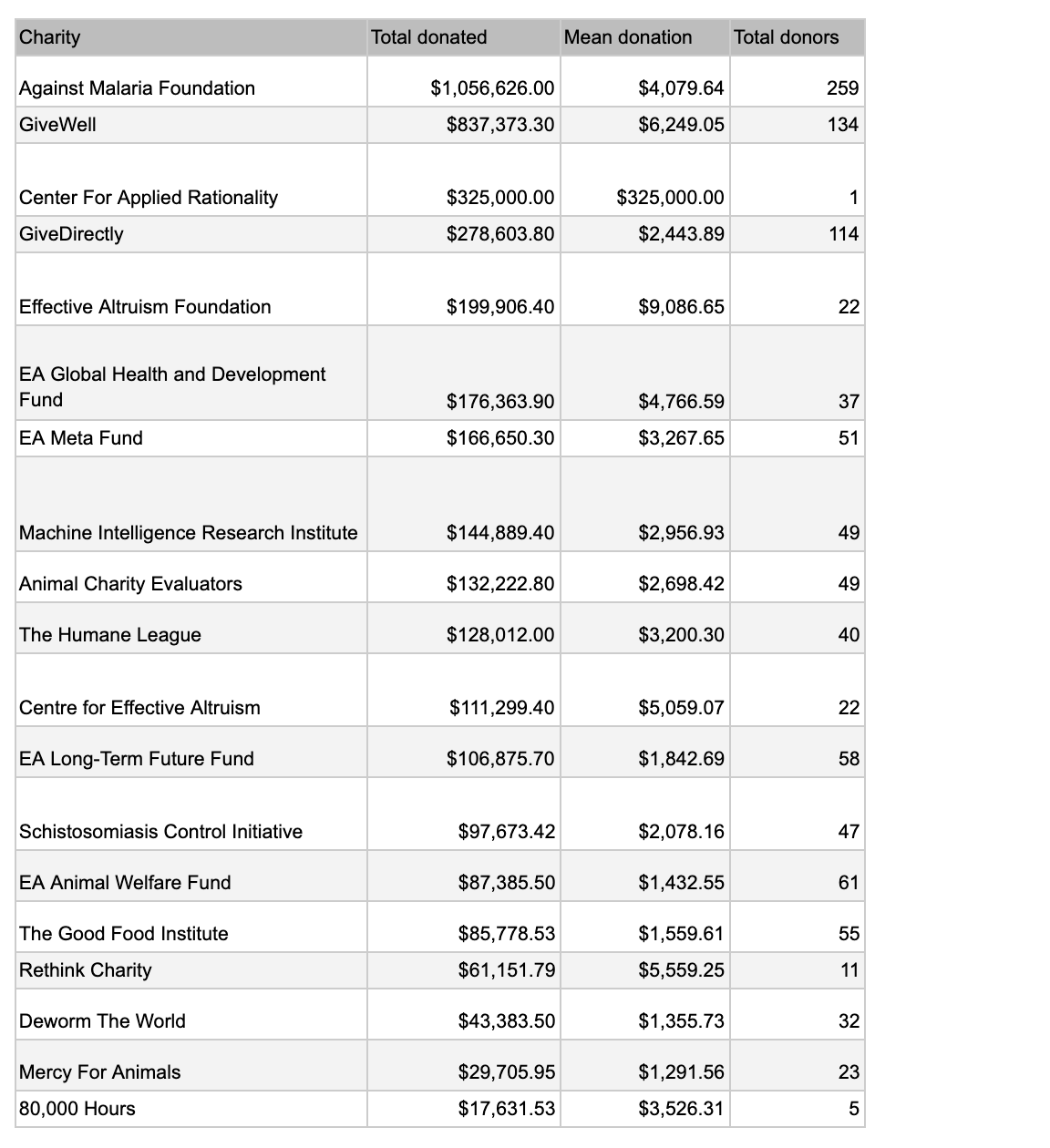
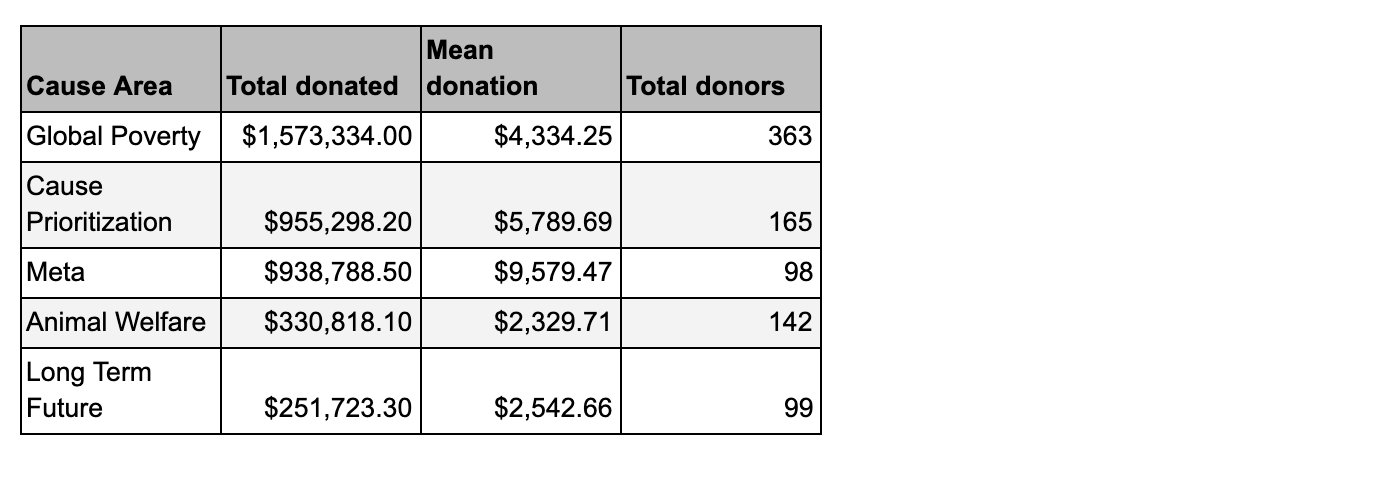
Updates and Corrections
The original version of this post included a table with the incorrect number of total donors per specific charity.
Credits

The annual EA Survey is a project of Rethink Charity with analysis and commentary from researchers at Rethink Priorities.
This essay was written by Neil Dullaghan. Thanks to David Moss and Peter Hurford for comments and Kim Cuddington for data analysis assistance.
If you like our work, please consider subscribing to our newsletter. You can see all our work to date here.
Other articles in the EA Survey 2019 Series can be found here
Only 5.5% (97) said a significant barrier to becoming more involved in EA was that it is not clear where one should donate. ↩︎
Data reported in other currencies was calculated into USD using the exchange rate of 13-November-2019. ↩︎
1,735 respondents in the 2019 EA Survey reported donation information, compared to 1,891 in the 2018 EA Survey. ↩︎
Although, looking at the median annual donation of only those EAs who provided both donation and income data the pattern is different, and considerably and highly engaged EAs donated similar amounts:
No engagement:$275.27 Mild: $771.19 Moderate: $875.98 Considerable: $1284.10 High: $1101.08 ↩︎Removing the outlier of $70M in income and $3M in donations changes the correlation to R^2=0.46, p = 2e-185 ↩︎


Minor:
Presuming backwards selection is stepwise elimination, this is not a great approach to model generation. See e.g. this from Frank Harrell: in essence, stepwise tends to be a recipe for overfitting, and thus the models it generates tend to have inflated goodness of fit measures (e.g. R2), overestimated coefficient estimates, and very hard to interpret p values (given the implicit multiple testing in the prior 'steps'). These problems are compounded by generating a large number of new variables (all interaction terms) for stepwise to play with.
Some improvements would be:
1. Select the variables by your judgement, and report that model. If you do any post-hoc additions (e.g. suspecting an interaction term), report these with the rider it is a post-hoc assessment.
2. Have a hold-out dataset to test your model (however you choose to generate it) against. (Cross-validation is an imperfect substitute).
3. Ridge, Lasso, elastic net or other approaches to variable selection.
(Repost comment from response to 2018):
In this years' post -- or, better yet, see the dynamic document here, in our predictive models we use elastic-net and random-forest modeling approaches with validation (cross-fold validation for tuning on training data, predictive power and model performance measured on set-aside testing data).
I'm involved with doing this analysis this year, andI hope we can go in this direction. Perhaps not in the first iteration, but as we refine it.
Coming soon...
I wonder how people in the EA community compare with people in general, notably controlling for income. I also wonder how much is given in the form of a reduced salary or volunteering, and how that compares to people in general.
I address this to some extent in the supplement to this year's comparable post; see the dynamic document here, let it auto-scroll down to the relevant section.
The major takeaway:
Recall that the mean share of total (imputed) income donated (for 2019) was 9.44% (imputing income where below 5k or missing).
If we focus on US-resident nonstudents across all years, the mean share is 7.94%.
awesome, thank you!
The SlateStarCodex survey data is useful to answer a limited form of that question (a comparison with other SSC-survey answerers).
Code here, in R, may be useful.
Thanks!